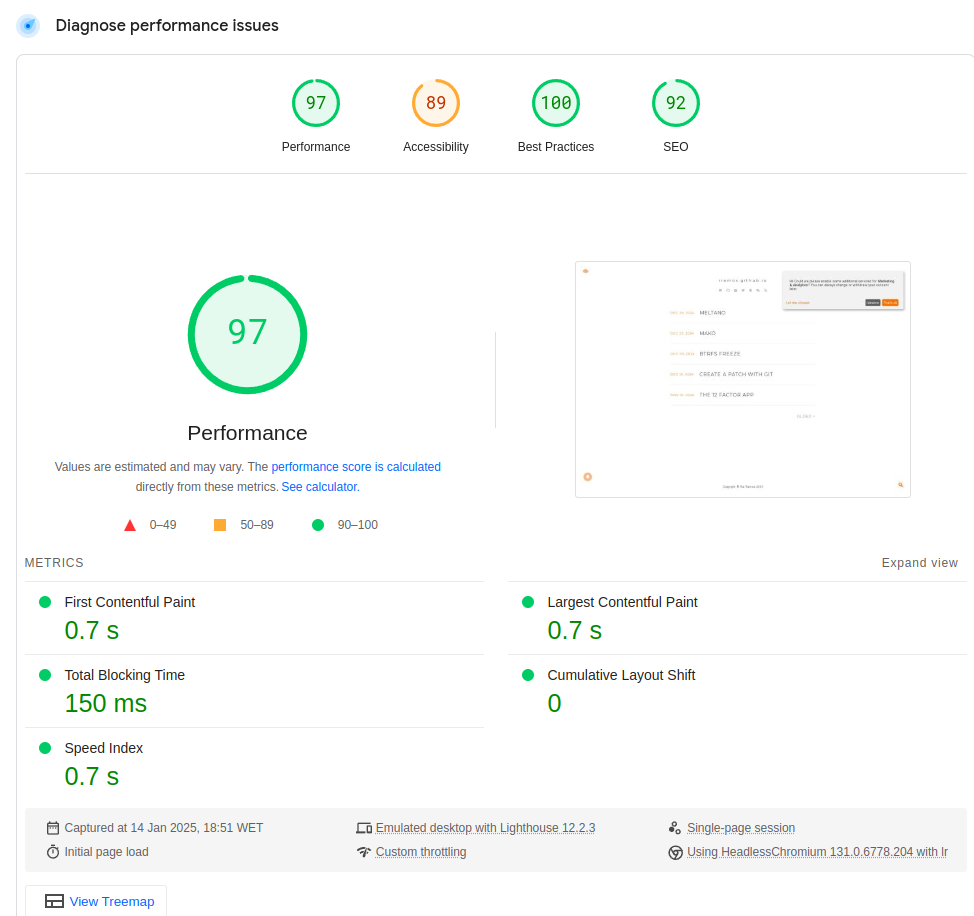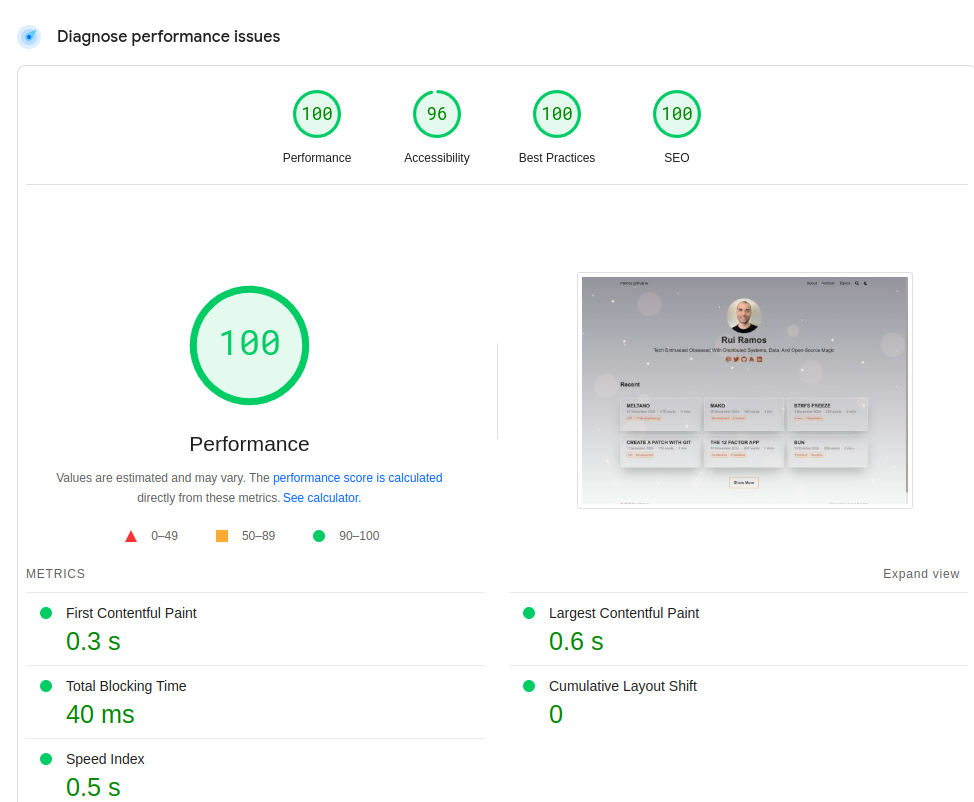This article describes the process to convert the blog from hexo to hugo motivations and conclusions
Intro#
Why change from Hexo to Hugo, you may find several pages providing insigths related with perfomance (ex: this). Although having a site with more performance would be a plus, I was looking to simplify the look, was sick of the lack of maintenance of the extension, and needed some excuse to dive into GoLang
Process#
The main idea for this process would be to:
- Create a new empty project in Hugo
- Pick a similar theme
- Make adjustments
- Copy articles
- Update GitHub Actions
Init project#
I’ve follow the guide and started a new project from scratch before messing up with the existing one.
This allowed me to test the existing themes, customizations and test the final look before adapting Github Actions.
Theme#
Next step was to choose a Theme that wasn’t to different from the actual Look, but would preferably support Light/Dark toogle.
I found a very intersting one which not only had what I intended and also a nice configuration tool, kudos to Nuno Coracao for this, check out his space https://themes.gohugo.io/themes/blowfish/
Convert Articles#
Articles metadata have some differences from hexo to hugo. It also will depend on the plugins you have. I toke this opportunity to clean up the metadata as the webpusher plugin was including extra info like workcounts whish I didn’t like
So I copied all the articles to the posts dir an run the following script to correct dates and clean up metadata.
# ensure dates don't start with single quotes
for file in *.md; do awk '{
if ($1 == "date:") {
gsub("\047", "", $0); print;
} else {
print $0;
}
}' "$file" > temp.md && mv temp.md $file ; done
# fix the dates and add the three dashes as the first line
for file in *.md; do awk '{
if ($1 == "date:") {
printf("%s %sT%s:00+00:00\n", $1, $2, $3);
} else {
print $0;
}
}' "$file" > temp.md && mv temp.md $file ; done
# wrap dates with quotes that aren't wrapped in quotes
for file in *.md; do awk '{
if ($1 == "date:") {
if ($2 ~ /^"/) {
print $0;
} else {
printf("%s \"%s\"\n", $1, $2);
}
} else { print $0; }
}' "$file" > temp.md && mv temp.md $file; done
# Removed published
for file in *.md; do
awk '
{
if ($1 == "published:" ||
$1 == "uuid:" ||
$1 == "webpushr:" ||
$1 == "wordCount:" ||
$1 == "charCount:" ||
$1 == "imgCount:" ||
$1 == "vidCount:" ||
$1 == "wsCount:" ||
$1 == "cbCount:" ||
$1 == "readTime:") {
next;
}
print;
}
' "$file" > temp.md && mv temp.md $file; done
# Removed Excerpt
for file in *.md; do
pattern="## Excerpt ##"
sed -i "/$pattern/d" "$file"
done
This allowed to start the server but there are still some issues with images that needed fixing.
Images#
Tag plugins don’t work so entries like <%blockquote> need to be changed. The same applies to images. I could do some sort of script, but I do’t have much images so I did fix those manually changing for example:
{% asset_img “screenshot-overview.png” %}
to

I also toke the time to reorganized a bit the images
The following section provide more details for Page bundles which uses a similar organization, but I opted to simplify this needs to be explored
URLs#
The hexo pages use different url paths for that hugo needed to include an extra configuration to keep the same urls
[permalinks]
[permalinks.page]
posts = '/:year/:month/:slug/'
The following section explains this more in detail in case you use a different pattern https://gohugo.io/content-management/urls .
That fixed keeping the same pattern.
Not sure if that is a better alternative, but I will check later if is possible to generate lists aggregate by year/month
Front Matter Consistancy#
When using Hugo cli to create new content it generates the front matter in toml format, like the folling example
+++
date = 2024-02-02T04:14:54-08:00
draft = false
title = 'Example'
weight = 10
[params]
author = 'John Smith'
+++
I tried to change the default metadata format to yaml with the following configuration metaDataFormat but seems not be working, the following thread could bring some light on the subject.
I updated the following file archetypes/default.md with
---
date: '{{ .Date }}'
draft: true
title: '{{ replace .File.ContentBaseName "-" " " | title }}'
lang: en
tags:
- Linux
---
And that seemd to do the trick.
GitHub Pages#
In the actual GitHub Pages for Hexo I have two repos, one for the site itself and another one for the source code.
The following page provides detailed information on how to setup the repo for Github Pages (Hugo is way better documented than Hexo by the way ).
NOTE: This next step would be destructive, as it will reset the existing repo for a clean state and use the existing local repo.
The good news is that I just need to keep a single repo and GitHubpages will deal with the rest.
Steps
- Deleted the github repo rramos.github.io
- Re-create the same repo
- Push the git content from Hugo to this new repo
- Went into Settings and activate Github Pages
- Included the workflow for Hugo
The existing Github Action pipeline for hexo takes arround 36s to build and deploy the changes.
Build Performance Metrics#
Generation time reference with Hexo
INFO 234 files generated in 283 ms
Generation time with Hugo
hugo v0.140.2+extended linux/amd64 BuildDate=unknown
| EN
-------------------+------
Pages | 465
Paginator pages | 2
Non-page files | 19
Static files | 10
Processed images | 1
Aliases | 161
Cleaned | 0
Total in 235 ms
Page Performance#
Using Google PageSpeed Insights, to check changes
Before#

After#

Analytics#
Google Analytics is also working out of the box, just applying the configuration
Conclusion#
In this article I’ve went through the process of converting a Blog from Hexo to Hugo. Although Hexo provides simplicity and lots of plugins with was becoming hard to manage updates and I was looking for a fresher look.
Also this would be an opportunity to delve into Go.
Regarging performance there are amazing gains, specially on the build factor and the site looks more responsive as the insights also confirm.
In geral I’m happy with the transition, but let’s check next months how this works out.
Next Steps#
Next steps will include some way to improve my writing pipeline. Why Hexo I consolidate all in Code with a Hexo plugin. I could try FrontMatter for Hugo but not sure yet if that would be the best approach.
I also will need to reconfigure Trunk and pre-commit on the repo to validate posts on grammar errors before commiting changes.